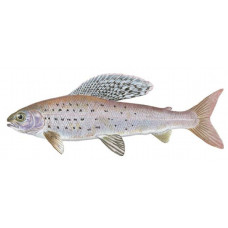Latin name
Thymallus arcticus
Other names
American grayling, arctic trout, Back’s grayling, bluefish, grayling, sailfin arctic grayling; French: ombre artique, poisson bleu.
Identification
Graceful lines, large fins and spectacular coloration make the grayling a striking fish. The most striking feature is the large purple to black dorsal fin, which extends backward to the tail blade and is mottled with rows of spots. This fin can appear bluish when the fish is in the water. The grayling is gray-silver overall, usually with shades or highlights of gold, lavender, or both, and many dark spots, which in some fish may be X- or V-shaped. Juvenile Arctic grayling can be distinguished from similar young whitefish by their narrow vertical barring (whitefish have round barring, if any). When the Arctic grayling is taken out of the water, the resemblance to whitefish becomes even more obvious as the beautiful colors fade to a dull gray. It has a small, narrow mouth with numerous small teeth in both jaws. The Arctic grayling also has a forked caudal fin and relatively large, stiff scales.
Distribution
Arctic grayling are found in Arctic rivers from Hudson Bay to Alaska and throughout central Alberta and British Columbia, as well as the upper Missouri River in Montana. Arctic grayling were previously known to inhabit some of the rivers feeding Lakes Guron, Michigan, and Superior in northern Michigan, but have been considered extinct there since 1936. They have been widely introduced elsewhere, particularly in the western United States.
Habitat
Grayling prefer clean, cold, well-oxygenated waters of medium to large rivers and lakes. They are most commonly found in rivers, especially in eddies and the upper reaches of channels and basins. In lakes, they prefer estuaries and rocky shores. They usually seek shelter among small rocks at the bottom of a stream or lake.
Size
A small fish with a maximum length of up to 30 inches, grayling can reach a maximum weight of about 6 pounds. The world record for Arctic grayling on any tackle is a 5-pound, 15-ounce fish from Canada's Northwest Territories, but any Arctic grayling over 3 pounds is considered large and a 4-pound fish is considered a trophy.
Life history and Behavior
Adult grayling spawn in stony streams from April to June. Fish from the lakes move to tributaries to spawn. Instead of building nests, they scatter the eggs on the gravel and rely on the water to cover the eggs with a protective shell. The eggs hatch within 13 to 18 days. Grayling are gregarious and thrive in schools consisting of a moderate number of individuals of their species. The Arctic grayling of northern Canada can be particularly abundant in certain river reaches.
Food and feeding habits
Juvenile grayling feed on zooplankton, and as adults they feed mainly on insects, small fish, fish roe, and less often on lemmings and planktonic crustaceans.
Reproduction
No information
| Classification | |
| Phylum | Chordata |
| Class | Actinopterygii |
| Squad | Salmoniformes |
| Family | Salmonidae |
| Genus | Thymallus |
| Species | T. arcticus |
| Features | |
| Conservation status | Least Concern |
| Habitat | Pelagic |
| Life span, years | No information |
| Maximum body weight, kg | 3.8 |
| Maximum length, cm | 76 |
| Sailing speed, m/s | No information |
| Threat to people | Edible |
| Way of eating | Predator |


